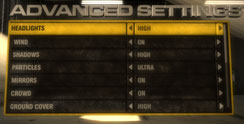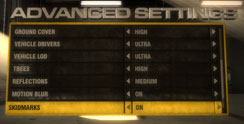Core i7 Christmas '08 Graphics Performance
Written by Tim Smalley
December 17, 2008 | 13:42
Tags: #1gb #2008 #216 #240 #260 #280 #2gb #4870 #512mb #benchmark #card #crossfire #evaluation #geforce #gtx #hd #performance #radeon #review #shader #sli #x2
Companies: #ati #bit-tech #christmas #nvidia #test

Race Driver: GRID
Publisher: CodemastersRace Driver: GRID is one of the best racing games to grace the PC in some time, striking a fine balance between automotive simulation and arcade throttle-fest which has resulted in an enormously entertaining game. Players can choose from racing tuned saloons through city streets, through to driving Lamborghinis around Le Mans, with all cars displaying a highly detailed damage model.
GRID runs on a modified version of Codemasters' own in house Neon engine, rechristened Ego for GRID. This will also be the engine used in the highly anticipated Operation Flashpoint 2: Dragon Rising, so hopefully GRID will give us a good indication of how hardware will perform in this future title too. Despite only supporting DirectX 9.0c, GRID features a lot of high level graphical features, including motion blur, fantastic smoke effects, dynamic track side details and thousands of fully 3D spectators.
To test performance in GRID, we raced a lap of the "San Francisco Short Circuit" track in the RADT Nissan Skyline Z-tune, starting from the back of the grid to ensure as many cars on screen for as long as possible. We chose the San Francisco circuit due to the large amount of dynamic track side details like flags and spectators visible from the track, and for the close proximity of track side objects.
However, GRID does not support anisotropic filtering in game, so we had to force this to 16x using the Forceware and Catalyst drivers. We captured the average and minimum frame rates during the lap, and the results you see below are indicative of around one minute and forty seconds of gameplay (average lap time) per setting.
Race Driver: GRID
1,680 x 1,050 4xAA 16xAF, DirectX 9, Maximum Detail
- ATI Radeon HD 4870 1GB CrossFire
- ATI Radeon HD 4870 X2 2GB
- Nvidia GeForce GTX 280 1GB SLI
- Nvidia GeForce GTX 260+ 896MB SLI
- Nvidia GeForce GTX 280 1GB
- ATI Radeon HD 4870 1GB
- ATI Radeon HD 4870 512MB
- Nvidia GeForce GTX 260+ 896MB
-
-
122.2
-
97.0
-
-
-
118.4
-
93.0
-
-
-
105.7
-
78.0
-
-
-
103.4
-
76.0
-
-
-
82.5
-
64.0
-
-
-
77.1
-
63.0
-
-
-
76.9
-
63.0
-
-
-
75.1
-
58.0
-
0
25
50
75
100
125
Frames Per Second
-
Average
-
Minimum
Race Driver: GRID
1,680 x 1,050 8xAA 16xAF, DirectX 9, Maximum Detail
- ATI Radeon HD 4870 1GB CrossFire
- ATI Radeon HD 4870 X2 2GB
- Nvidia GeForce GTX 280 1GB SLI
- Nvidia GeForce GTX 260+ 896MB SLI
- Nvidia GeForce GTX 280 1GB
- ATI Radeon HD 4870 1GB
- ATI Radeon HD 4870 512MB
- Nvidia GeForce GTX 260+ 896MB
-
-
120.5
-
96.0
-
-
-
117.0
-
92.0
-
-
-
103.2
-
75.0
-
-
-
101.4
-
75.0
-
-
-
76.8
-
58.0
-
-
-
74.6
-
60.0
-
-
-
65.9
-
43.0
-
-
-
60.9
-
49.0
-
0
25
50
75
100
125
Frames Per Second
-
Average
-
Minimum
Race Driver: GRID
1,920 x 1,200 4xAA 16xAF, DirectX 9, Maximum Detail
- ATI Radeon HD 4870 1GB CrossFire
- ATI Radeon HD 4870 X2 2GB
- Nvidia GeForce GTX 280 1GB SLI
- Nvidia GeForce GTX 260+ 896MB SLI
- Nvidia GeForce GTX 280 1GB
- ATI Radeon HD 4870 1GB
- ATI Radeon HD 4870 512MB
- Nvidia GeForce GTX 260+ 896MB
-
-
114.6
-
87.0
-
-
-
110.5
-
85.0
-
-
-
102.3
-
75.0
-
-
-
101.4
-
75.0
-
-
-
70.4
-
53.0
-
-
-
69.4
-
57.0
-
-
-
68.2
-
51.0
-
-
-
60.9
-
49.0
-
0
25
50
75
100
125
Frames Per Second
-
Average
-
Minimum
Race Driver: GRID
1,920 x 1,200 8xAA 16xAF, DirectX 9, Maximum Detail
- ATI Radeon HD 4870 1GB CrossFire
- ATI Radeon HD 4870 X2 2GB
- Nvidia GeForce GTX 280 1GB SLI
- Nvidia GeForce GTX 260+ 896MB SLI
- ATI Radeon HD 4870 1GB
- Nvidia GeForce GTX 280 1GB
- Nvidia GeForce GTX 260+ 896MB
- ATI Radeon HD 4870 512MB
-
-
108.9
-
79.0
-
-
-
104.9
-
74.0
-
-
-
99.4
-
73.0
-
-
-
93.0
-
74.0
-
-
-
66.1
-
53.0
-
-
-
58.2
-
47.0
-
-
-
53.7
-
43.0
-
-
-
53.1
-
37.0
-
0
25
50
75
100
Frames Per Second
-
Average
-
Minimum
Race Driver: GRID
2,560 x 1,600 0xAA 16xAF, DirectX 9, Maximum Detail
- ATI Radeon HD 4870 1GB CrossFire
- Nvidia GeForce GTX 280 1GB SLI
- ATI Radeon HD 4870 X2 2GB
- Nvidia GeForce GTX 260+ 896MB SLI
- Nvidia GeForce GTX 280 1GB
- ATI Radeon HD 4870 1GB
- ATI Radeon HD 4870 512MB
- Nvidia GeForce GTX 260+ 896MB
-
-
99.3
-
81.0
-
-
-
98.0
-
76.0
-
-
-
97.3
-
77.0
-
-
-
88.9
-
70.0
-
-
-
58.7
-
47.0
-
-
-
54.1
-
46.0
-
-
-
54.1
-
43.0
-
-
-
49.7
-
38.0
-
0
25
50
75
100
Frames Per Second
-
Average
-
Minimum
Race Driver: GRID
2,560 x 1,600 4xAA 16xAF, DirectX 9, Maximum Detail
- Nvidia GeForce GTX 280 1GB SLI
- ATI Radeon HD 4870 1GB CrossFire
- ATI Radeon HD 4870 X2 2GB
- Nvidia GeForce GTX 260+ 896MB SLI
- ATI Radeon HD 4870 1GB
- Nvidia GeForce GTX 280 1GB
- Nvidia GeForce GTX 260+ 896MB
- ATI Radeon HD 4870 512MB
-
-
85.8
-
66.0
-
-
-
84.9
-
63.0
-
-
-
82.0
-
59.0
-
-
-
73.6
-
62.0
-
-
-
48.9
-
38.0
-
-
-
45.7
-
37.0
-
-
-
40.7
-
32.0
-
-
-
8.8
- 5.0
-
0
10
20
30
40
50
60
70
80
90
Frames Per Second
-
Average
-
Minimum
GRID has long been a game that favours the Radeons and it's no different with the new drivers from both companies. That said, Nvidia has done quite a bit of catching up with release 180, but it’s the anti-aliasing performance that really lets the GeForces down in this title.
The Radeon HD 4870 1GB is not only significantly faster than the GeForce GTX 260+ in every test, but it's also quicker than the GTX 280 in a lot of scenarios as well. That's not a good sign for Nvidia, but the frame rates are solid enough.
Where Nvidia has done some work is with SLI – despite a single GeForce GTX 280 being slower than the Radeon HD 4870 1GB, a pair of them does end up marginally faster than the 4870 1GB CrossFire setup. The GTX 260+ SLI configuration isn't fast enough to compete with Radeon HD 4870 1GB CrossFire though – it's still 15 percent slower at 2,560 x 1,600 with 4xAA applied.












Want to comment? Please log in.